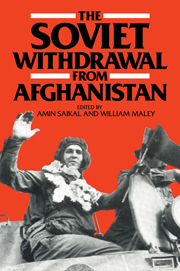Book contents
- Frontmatter
- Contents
- Preface
- 1 Introduction
- 2 The Geneva Accords of April 1988
- 3 Post-Withdrawal Afghanistan: Light at the End of the Tunnel
- 4 The Regional Politics of the Afghan Crisis
- 5 The Afghan Conflict and Soviet Domestic Politics
- 6 The Soviet Armed Forces and the Afghan War
- 7 Afghanistan and Soviet Alliances
- 8 Afghanistan and Sino-Soviet Relations
- 9 The Afghanistan 'Settlement' and the Future of World Politics
- 10 Conclusions: Management of the Afghan Crisis
- List of Contributors
- Index
8 - Afghanistan and Sino-Soviet Relations
Published online by Cambridge University Press: 09 November 2009
- Frontmatter
- Contents
- Preface
- 1 Introduction
- 2 The Geneva Accords of April 1988
- 3 Post-Withdrawal Afghanistan: Light at the End of the Tunnel
- 4 The Regional Politics of the Afghan Crisis
- 5 The Afghan Conflict and Soviet Domestic Politics
- 6 The Soviet Armed Forces and the Afghan War
- 7 Afghanistan and Soviet Alliances
- 8 Afghanistan and Sino-Soviet Relations
- 9 The Afghanistan 'Settlement' and the Future of World Politics
- 10 Conclusions: Management of the Afghan Crisis
- List of Contributors
- Index
Summary
Of one aspect of Sino-Soviet relations we can be certain: the Soviet withdrawal of troops from Afghanistan will not of itself be sufficient to allay long-standing Chinese fears about Soviet global—especially Asian—hegemonic intentions. Nor will it alter the fact that the People's Republic of China (PRC) is fully aware that it must be careful to balance improvements in relations with the USSR against its strategic and economic interest in maintaining or even improving its relationship with the capitalist West, especially the USA.
In any assessment of likely future developments in the Sino-Soviet relationship, it is important to consider at least the two issues other than Afghanistan that the Chinese have long and explicitly maintained must be resolved before any fundamental improvement in Sino-Soviet relations can occur—namely Soviet support of the Vietnamese occupation of Kampuchea and the large Soviet military presence just over China's borders. The Chinese have made it clear that the Afghanistan issue is less important to them certainly than the first of these and, possibly, than the second—although, as shall be demonstrated, the Afghan question cannot be completely separated from the Soviet military encirclement issue. The last point notwithstanding, Klintworth is thus in my view correct when he argues that ‘China in fact no longer regards Afghanistan with the same degree of apprehension about Soviet encirclement as it did in 1979’.
But to consider only the ‘three obstacles’ is insufficient for a full analysis of the current state of Sino-Soviet relations.
- Type
- Chapter
- Information
- The Soviet Withdrawal from Afghanistan , pp. 122 - 141Publisher: Cambridge University PressPrint publication year: 1989
- 2
- Cited by

